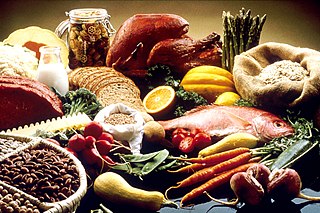| Part of a series on |
| Meals |
|---|
 |
| Meals |
| Components and courses |
| Related concepts |
Meal preparation, sometimes called meal prep, is the process of planning and preparing meals while pre packaging the meals you will eat throughout the week.
| Part of a series on |
| Meals |
|---|
 |
| Meals |
| Components and courses |
| Related concepts |
Meal preparation, sometimes called meal prep, is the process of planning and preparing meals while pre packaging the meals you will eat throughout the week.

Meal preparation involves preparing meals ahead of time. [1] This practice may occur among people who desire to lose weight, gain muscle mass, or maintain a healthy lifestyle. Advance preparation can serve to standardize food portions. Prepared meals are fully cooked. [2] Meals may be prepared in small containers such as Tupperware, and are sometimes labeled and dated to remain organized.
By preparing meals in advance, there is a limited need for an individual to purchase food from restaurants or bars, which can have an average markup rate of around 300%. [3] According to the 2020 Consumer Expenditures Report from the Bureau of Labor Statistics, there was a 32.6 percent decrease in spending of food away from home from 2019 to 2020 and, simultaneously, there was a 6.4 percent increase in spending in food at home (which is defined as food at grocery stores and other food stores where the final purchaser is the consumer.) [4] [5] These trends can be attributed to the rise of the COVID-19 during this period as consumers were more hesitant to eat out at this time. The rise in spending for food at home and decrease for food away from home means people were preparing more food at home. Which led to the average consumer saving approximately $1151 from eating out less from 2019 to 2020. [6]
By using fresh, healthy ingredients as opposed to eating out or consuming a higher volume of processed foods, meal preparation provides numerous health benefits over eating outside of the home frequently. For example, multiple studies have shown that those who consume meals that were prepared at home more often had a significantly lower risk of acquiring type 2 diabetes mellitus. [7] [8] On the contrary, those who meal prep less and eat out more and consume more processed foods have seen to have a significantly higher risk of getting conditions such as hypertension, dyslipidemia, or cancer. [9] Studies have also shown that individuals who eat more meals out, consume a significantly higher amount of sugar and fat and a significantly lower amount of important micronutrients such as iron, calcium and vitamin C. [10]

Cooking, also known as cookery or professionally as the culinary arts, is the art, science and craft of using heat to make food more palatable, digestible, nutritious, or safe. Cooking techniques and ingredients vary widely, from grilling food over an open fire, to using electric stoves, to baking in various types of ovens, reflecting local conditions. Cooking is an aspect of all human societies and a cultural universal.

Dairy products or milk products, also known as lacticinia, are food products made from milk. The most common dairy animals are cow, water buffalo, nanny goat, and ewe. Dairy products include common grocery store food around the world such as yogurt, cheese, milk and butter. A facility that produces dairy products is a dairy. Dairy products are consumed worldwide to varying degrees. Some people avoid some or all dairy products because of lactose intolerance, veganism, environmental concerns, other health reasons or beliefs.

Fast food is a type of mass-produced food designed for commercial resale, with a strong priority placed on speed of service. Fast food is a commercial term, limited to food sold in a restaurant or store with frozen, preheated or precooked ingredients and served in packaging for take-out or takeaway. Fast food was created as a commercial strategy to accommodate large numbers of busy commuters, travelers and wage workers. In 2018, the fast-food industry was worth an estimated $570 billion globally.

Convenience food is food that is commercially prepared for ease of consumption, and is usually ready to eat without further preparation. It may also be easily portable, have a long shelf life, or offer a combination of such convenient traits. Convenience foods include ready-to-eat dry products, frozen food such as TV dinners, shelf-stable food, prepared mixes such as cake mix, and snack food. Food scientists now consider most of these products to be ultra-processed foods and link them to poor health outcomes.

Food processing is the transformation of agricultural products into food, or of one form of food into other forms. Food processing takes many forms, from grinding grain into raw flour, home cooking, and complex industrial methods used in the making of convenience foods. Some food processing methods play important roles in reducing food waste and improving food preservation, thus reducing the total environmental impact of agriculture and improving food security.

A plant-based diet is a diet consisting mostly or entirely of plant-based foods. Plant-based diets encompass a wide range of dietary patterns that contain low amounts of animal products and high amounts of fiber-rich plant products such as vegetables, fruits, whole grains, legumes, nuts and seeds. They do not need to be vegan or vegetarian, but are defined in terms of low frequency of animal food consumption.

A cook is a professional individual who prepares items for consumption in the food industry, especially in settings such as restaurants. A cook is sometimes referred to as a chef, although in the culinary world, the terms are not interchangeable. Cooks' responsibilities include preparing food, managing food stations, cleaning the kitchen, and helping the chefs. Restaurants will give a title to the cooks according to their designated stations. Examples are broiler cooks, fry cooks, pantry cooks, and sauce cooks.

A healthy diet is a diet that maintains or improves overall health. A healthy diet provides the body with essential nutrition: fluid, macronutrients such as protein, micronutrients such as vitamins, and adequate fibre and food energy.

Many species of fish are caught by humans and consumed as food in virtually all regions around the world. Fish has been an important dietary source of protein and other nutrients.

Childhood obesity is a condition where excess body fat negatively affects a child's health or well-being. As methods to determine body fat directly are difficult, the diagnosis of obesity is often based on BMI. Due to the rising prevalence of obesity in children and its many adverse health effects it is being recognized as a serious public health concern. The term overweight rather than obese is often used when discussing childhood obesity, as it is less stigmatizing, although the term overweight can also refer to a different BMI category. The prevalence of childhood obesity is known to differ by sex and gender.

Online food ordering is the process of ordering food, for delivery or pickup, from a website or other application. The product can be either ready-to-eat food or food that has not been specially prepared for direct consumption.

The Western pattern diet is a modern dietary pattern that is generally characterized by high intakes of pre-packaged foods, refined grains, red meat, processed meat, high-sugar drinks, candy and sweets, fried foods, industrially produced animal products, butter and other high-fat dairy products, eggs, potatoes, corn, and low intakes of fruits, vegetables, whole grains, pasture-raised animal products, fish, nuts, and seeds.

Diet plays an important role in the genesis of obesity. Personal choices, food advertising, social customs and cultural influences, as well as food availability and pricing all play a role in determining what and how much an individual eats.

While genetic influences are important to understanding obesity, they cannot explain the current dramatic increase seen within specific countries or globally. It is accepted that calorie consumption in excess of calorie expenditure leads to obesity; however, what has caused shifts in these two factors on a global scale is much debated.

Weight management refers to behaviors, techniques, and physiological processes that contribute to a person's ability to attain and maintain a healthy weight. Most weight management techniques encompass long-term lifestyle strategies that promote healthy eating and daily physical activity. Moreover, weight management involves developing meaningful ways to track weight over time and to identify the ideal body weights for different individuals.
Research into food choice investigates how people select the food they eat. An interdisciplinary topic, food choice comprises psychological and sociological aspects, economic issues and sensory aspects.

Criticism of fast food includes claims of negative health effects, animal cruelty, cases of worker exploitation, children-targeted marketing and claims of cultural degradation via shifts in people's eating patterns away from traditional foods. Fast food chains have come under fire from consumer groups, such as the Center for Science in the Public Interest, a longtime fast food critic over issues such as caloric content, trans fats and portion sizes. Social scientists have highlighted how the prominence of fast food narratives in popular urban legends suggests that modern consumers have an ambivalent relationship with fast food, particularly in relation to children.

Social class differences in food consumption refers to how the quantity and quality of food varies according to a person's social status or position in the social hierarchy. Various disciplines, including social, psychological, nutritional, and public health sciences, have examined this topic. Social class can be examined according to defining factors — education, income, or occupational status — or subjective components, like perceived rank in society.

A meal is an eating occasion that takes place at a certain time and includes consumption of food. The names used for specific meals in English vary, depending on the speaker's culture, the time of day, or the size of the meal.

Ultra-processed foods (UPFs) are industrially manufactured foods that are designed to be convenient, palatable, and affordable. These foods often contain multiple ingredients and additives such as preservatives, sweeteners, colorings, and emulsifiers, which are not typically found in home kitchens. They tend to be low in fiber and high in calories, salt, added sugar and fat, which are all related to poor health outcomes when eaten excessively. Common examples include packaged snacks, soft drinks, ready meals, and processed meats.